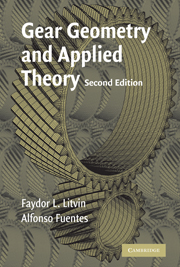Book contents
- Frontmatter
- Contents
- Foreword by Graziano Curti
- Preface
- Acknowledgments
- 1 Coordinate Transformation
- 2 Relative Velocity
- 3 Centrodes, Axodes, and Operating Pitch Surfaces
- 4 Planar Curves
- 5 Surfaces
- 6 Conjugated Surfaces and Curves
- 7 Curvatures of Surfaces and Curves
- 8 Mating Surfaces: Curvature Relations, Contact Ellipse
- 9 Computerized Simulation of Meshing and Contact
- 10 Spur Involute Gears
- 11 Internal Involute Gears
- 12 Noncircular Gears
- 13 Cycloidal Gearing
- 14 Involute Helical Gears with Parallel Axes
- 15 Modified Involute Gears
- 16 Involute Helical Gears with Crossed Axes
- 17 New Version of Novikov–Wildhaber Helical Gears
- 18 Face-Gear Drives
- 19 Worm-Gear Drives with Cylindrical Worms
- 20 Double-Enveloping Worm-Gear Drives
- 21 Spiral Bevel Gears
- 22 Hypoid Gear Drives
- 23 Planetary Gear Trains
- 24 Generation of Helicoids
- 25 Design of Flyblades
- 26 Generation of Surfaces by CNC Machines
- 27 Overwire (Ball) Measurement
- 28 Minimization of Deviations of Gear Real Tooth Surfaces
- References
- Index
27 - Overwire (Ball) Measurement
Published online by Cambridge University Press: 04 September 2009
- Frontmatter
- Contents
- Foreword by Graziano Curti
- Preface
- Acknowledgments
- 1 Coordinate Transformation
- 2 Relative Velocity
- 3 Centrodes, Axodes, and Operating Pitch Surfaces
- 4 Planar Curves
- 5 Surfaces
- 6 Conjugated Surfaces and Curves
- 7 Curvatures of Surfaces and Curves
- 8 Mating Surfaces: Curvature Relations, Contact Ellipse
- 9 Computerized Simulation of Meshing and Contact
- 10 Spur Involute Gears
- 11 Internal Involute Gears
- 12 Noncircular Gears
- 13 Cycloidal Gearing
- 14 Involute Helical Gears with Parallel Axes
- 15 Modified Involute Gears
- 16 Involute Helical Gears with Crossed Axes
- 17 New Version of Novikov–Wildhaber Helical Gears
- 18 Face-Gear Drives
- 19 Worm-Gear Drives with Cylindrical Worms
- 20 Double-Enveloping Worm-Gear Drives
- 21 Spiral Bevel Gears
- 22 Hypoid Gear Drives
- 23 Planetary Gear Trains
- 24 Generation of Helicoids
- 25 Design of Flyblades
- 26 Generation of Surfaces by CNC Machines
- 27 Overwire (Ball) Measurement
- 28 Minimization of Deviations of Gear Real Tooth Surfaces
- References
- Index
Summary
INTRODUCTION
Indirect determination of gear tooth thickness by overwire (ball) measurement has found broad application. This topic has been the subject of research by many scientists. The earliest publications dealing with such measurement of worms and spatial gears are Litvin's papers and books. Detailed references regarding the history of the performed research are given in Litvin [1968].
The application of computers and subroutines for the solution of systems of nonlinear equations is a significant step forward in this area that was accomplished by Litvin et al. [1998b]. This chapter covers the following topics:
(i) Algorithms for determination of location of a wire or a ball placed into the space of a workpiece with symmetric and nonsymmetric location of tooth surfaces
(ii) Relation between the tooth thickness and overwire measurement – this relation enables us to use the developed algorithms for a workpiece with various tolerances.
The developed theory was applied for measurement of tooth thickness of worms, screws, and involute helical gears. Computer programs for this purpose have been developed.
PROBLEM DESCRIPTION
Consider that a ball (a wire) is placed into the space of a workpiece (a worm, screw, or gear). The surfaces of the ball and the workpiece are in tangency at two points whose location depends on the geometry of the surfaces of the workpiece, the width of the space, and the diameter of the ball. The surface geometry of the workpiece is represented analytically and the width of the space and the ball (wire) diameter are given.
- Type
- Chapter
- Information
- Gear Geometry and Applied Theory , pp. 769 - 781Publisher: Cambridge University PressPrint publication year: 2004



